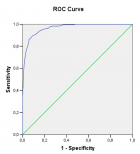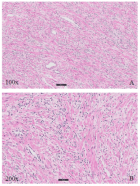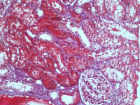Abstract
Research Article
Non-hemodynamic factors associated to the risk of developing hypertensive cardiopathy
Alexis Álvarez-Aliaga*, Julio César González-Aguilera, Liliana del Rosario Maceo-Gómez, Lic David del Llano Sosa, Raúl Leyva-Castro and Rosa Ojeda-Vázquez
Published: 20 September, 2017 | Volume 2 - Issue 1 | Pages: 068-084
Introduction: Hypertensive cardiopathy is the target organ lesion caused by arterial hypertension (HTN) that exhibits the highest morbidity and mortality rates. Although the importance of hemodynamic overload exerted by HTN on the onset of cardiopathy is well established, several non-hemodynamic factors may contribute significantly to its development.
Objective: To evaluate the influence of different non-hemodynamic risk factors in the development of hypertensive cardiopathy.
Methods: A prospective cohort study was carried out in hypertensive patients assisted at the specialized arterial hypertension physicians’ office of the “Carlos Manuel de Céspedes” Specialty Policlinic attached to the General University Hospital, Bayamo Municipality, Granma Province, Cuba from January 5, 2006 to December 31, 2015. The study included 18-to-55-year-old hypertensive patients with a stage 1 arterial hypertension diagnosis for less than a year1.
Results: The multivariate analysis showed a significant and independent relation among the majority of the factors studied and the risk of developing cardiopathy. The major factor was C-reactive protein (HR: 5.020; IC 95%: 3.383-7,448; p<0.005) followed by microalbuminuria (HR: 2.649; IC 95%: 1.932-3.631; p<0.005). The area under the model ROC curve was 0.887 (p<0,005).
Conclusions: The results showed that it is possible to estimate the risk of developing hypertensive cardiopathy with the application of the regression model to major risk factors.
Read Full Article HTML DOI: 10.29328/journal.jccm.1001017 Cite this Article Read Full Article PDF
Keywords:
Arterial hypertension; Hypertensive cardiopathy; Non-hemodynamic cardiovascular risk factors Abstract
References
- Mancia G, Fagard R, Narkiewicz K, Redon J, Zanchetti A, et al. Guía de práctica clínica de la ESH/ESC 2013 para el manejo de la hipertensión arterial. RevEspCardiol. 2013; 23: 3-16. Ref: https://goo.gl/pdLH5T
- Victor RG. Arterial hypertension. En: Lee Goldman L, Schafer AI, editors. Goldman-Cecil Medicine. 25th ed.Philadelphia, PA: ElsevierSaunders. 2016; 67: 381-397.
- República de Cuba. Ministerio de Salud Pública. Anuario Estadístico de Salud. 2016.
- Díez J, Frohlich ED. A translational approach to hypertensive heart disease. Hypertension. 2010; 55: 1-8. Ref: https://goo.gl/NyEqK8
- Tzoulaki I, Murray GD, Lee AJ, Rumley A, Lowe GDO, et al. Relative value of inflammatory, hemostatic, and rheological factors for incident myocardial infarction and stroke: the Edinburgh Artery Study. Circulation. 2007; 115: 2119-2127. Ref: https://goo.gl/hzbp9m
- Sharman JE. New insights into cardiovascular risk from the exercise central waveform. Artery Res. 2009; 2: 132-137. Ref: https://goo.gl/BpS9FK
- Tomiyama H, Matsumoto C, Yamada J, Yoshida M, Odaira M, et al. Predictors of progression from prehypertension to hypertension in Japanese men. Am J Hypertens. 2009; 22: 630-636. Ref: https://goo.gl/QXDu2D
- Álvarez Aliaga A, González Aguilera JC, Maceo Gómez LR. Factores asociados al desarrollo de la cardiopatía hipertensiva: un estudio de cohorte, en Bayamo, Cuba. Medwave2016; 16: 6492. Ref: https://goo.gl/KjbCaF
- Álvarez Aliaga A, González Aguilera JC. Algunos factores de riesgo de la cardiopatía hipertensiva. Rev Cubana de Med. 2009; 48: 139-151. Ref: https://goo.gl/LZnLPD
- Chobanian AV, Bakris GL, Black HR, Cushman WC, Green LA, et al. National Heart, Lung, and Blood Institute Joint National Committee on Prevention, Detection, Evaluation, and Treatment of High Blood Pressure. The Seventh Report of the Joint National Committee on Prevention, Detection, Evaluation, and Treatment of High Blood Pressure: the JNC 7 report. JAMA. 2003; 289: 2560-2572. Ref: https://goo.gl/21maJJ
- Dévereux RB, Reichek N. Echocardiographic determination of left ventricular mass in man. Anatomic validation of the method. Circulation. 1977; 55: 613-618. Ref: https://goo.gl/N3sdsr
- Pérez Caballero MD, Dueñas Herrera A, Alfonso Guerra JP, Vázquez Vigoa A, Navarro Despaigne D, et al. Hipertensión arterial. Guía para la prevención, diagnóstico y tratamiento. Comisión Nacional Técnica Asesora del Programa de Hipertensión Arterial. La Habana: Editorial Ciencias Médicas. 2008.
- Whelton S, Chin A, Xin X, He J. Effect of aerobic exercise on blood pressure: a meta-analysis of randomized, controlled trials. Ann Intern Med. 2002; 136: 493-503. Ref: https://goo.gl/8jtdSP
- Cabrera de León A, Rodríguez-Pérez C, Rodríguez-Benjumeda M, Anía-Lafuente B, Brito-Díaz B, et al. Sedentarismo: tiempo de ocio activo frente a porcentaje del gasto energético. RevEspCardiol. 2007; 60: 244-50. Ref: https://goo.gl/EpUDwi
- Zhao W, Hasegawa K, Chen J. Part A. Recent advances in dietary assessment tools. The use of food-frequency questionnaires for various purposes in China. Public Health Nutrition. 2002; 5: 829-833. Ref: https://goo.gl/M3zAAt
- Mazumdar M, Glassman JR. Categorizing a prognostic variable: review of methods, code for easy implementation and applications to decision-making about cancer treatments. Stat Med. 2000; 19: 113-132. Ref: https://goo.gl/A7MNWm
- Graf K, Schaefer-Graf UM. Is Smad3 the key to inflammation and fibrosis in hypertensive heart disease? Hypertension. 2010; 55: 1088-1089. Ref: https://goo.gl/KnonvS
- Drazner MH. The progression of hypertensive heart disease. Circulation. 2011; 123: 327- 334. Ref: https://goo.gl/AVmvg5
- Sehestedt T, Jeppesen J, Hansen TW, Rasmussen S, Wachtell K, et al. Which markers of subclinical organ damage to measure in individuals with high normal blood pressure? J Hypertens. 2009; 27: 1165-1171. Ref: https://goo.gl/jXron1
- Perkovic V, Verdon C, Ninomiya T, Barzi F, Cass A, et al. The Relationship between proteinuria and coronary risk: A systematic review and meta-analysis. PLoSMed. 2008; 5: 1486-1495. Ref: https://goo.gl/J8fLJC
- Maione A, Annemans L, Strippoli G. Proteinuria and clinical outcomes in hypertensive patients. Am J Hypertens. 2009; 22: 1137-1147. Ref: https://goo.gl/LxKXLg
- Zhang Z, Dzau VJ. Angiotensin II type 1 receptor–associated protein is an endogenous inhibitor of angiotensin II type 1 receptor action in cardiac hypertrophy. Role in check and balance. Hypertens. 2010; 55:1086-1087. Ref: https://goo.gl/RMHN9T
- Tocci G, Paneni F, Ponziani B, Volpe M. Use of predictive markers to improve cardiovascular protection. FutureCardiol. 2007; 3: 447-456. Ref: https://goo.gl/Axptnn
- Martínez-Castelao A, Górriz JL, Bover J, Segura-de la Morena J, Cebollada J, et al. Documento de consenso para la detección y manejo de la enfermedad renal crónica. Hipertens Riesgo Vasc. 2014; 46: 501-519. Ref: https://goo.gl/ki1f1w
- Halperin RO, Michael Gaziano JM, Howard D, Sesso HD. Smoking and the risk of incident hypertension in middle-aged and older men. Am J Hypertens. 2008; 21: 148-152. Ref: https://goo.gl/6DK9ug
- Johnson HM, Gossett LK, Piper ME, Aeschlimann SE, Korcarz CE, et al. Effects of smoking and smoking cessation on endothelial function 1-year outcomes from a randomized clinical trial. J Am CollCardiol. 2010; 55: 1988-1995. Ref: https://goo.gl/jW5LjH
- Schmidt AC, Flick B, Jahn E, Bramlage P. Effects of the vasodilating beta-blocker nebivolol on smoking-induced endothelial dysfunction in young healthy volunteers. Vasc Health Risk Manag. 2008; 4: 909-915. Ref: https://goo.gl/Mg88bR
- Appel LJ. The case for population-wide salt reduction gets stronger. BMJ. 2009; 339:b4980. Ref: https://goo.gl/rcBr9T
- Strazzullo P, D’Elia L, Kandala NB, Cappuccio FP. Salt intake, stroke, and cardiovascular disease: meta-analysis of prospective studies. BMJ. 2009; 339: 4567. Ref: https://goo.gl/6863jC
- He J, Ogden LG, Bazzano LA, Vupputuri S, Loria C, et al. Dietary sodium intake and incidence of congestive heart failure in overweight US men and women: first National Health and Nutrition Examination Survey epidemiologic follow-up study. Arch Intern Med. 2002; 162: 1619-1624. Ref: https://goo.gl/C3UzFE
- Haddy FJ. Role of dietary salt in hypertension. LifeSci. 2006; 79: 1585-1592. Ref: https://goo.gl/WFoaYs
- Frohlich ED. The salt conundrum: a hypothesis. Hypertension. 2007; 50: 161-166. Ref: https://goo.gl/p6RdEQ
- Cuspidi C, Valerio C, Sala C, Negri F, Esposito A, et al. Metabolic syndrome and biventricular hypertrophy in essential hypertension. J Hum Hypertens. 2009; 23: 168-175. Ref: https://goo.gl/xpZyxA
- Ärnlöv J, Ingelsson E, Sundström J, Lind L. Impact of body mass index and the metabolic syndrome on the risk of cardiovascular disease and death in middle-aged men. Circulation. 2010; 121: 230-236. Ref: https://goo.gl/gpZ9vq
- Alegría Ezquerra E, Castellano Vázquez JM, Alegría Barrero A. Obesidad, síndrome metabólico y diabetes: implicaciones cardiovasculares y actuación terapéutica. RevEspCardiol. 2008; 61: 752-764. Ref: https://goo.gl/QoQnss
- Son NH, Yu S, Tuinei J, Arai K, Hamai H, et al. PPARgamma-induced cardiolipotoxicity in mice is ameliorated by PPARalpha deficiency despite increases in fatty acid oxidation. J Clin Invest. 2010; 120: 3443-3454. Ref: https://goo.gl/fEM9c6
- Hernández del Rey R. ¿Es importante el ejercicio físico en el control del hipertenso? En: Coca A, de la Sierra A, editores. Decisiones clínicas y terapéuticas en el paciente hipertenso. 3a ed. Barcelona: JIMS SL. 2002; 313-320.
- Agarwal D, Haque M, Sriramula S, Mariappan N, Pariaut R, et al. Role of proinflammatory cytokines and redox homeostasis in exercise induced delayed progression of hypertension in spontaneously hypertensive rats. Hypertension. 2009; 54: 1393-1400. Ref: https://goo.gl/CRx6g5
- Wildman RP, Gu D, Muntner P, Huang G, Chen J, et al. Alcohol intake and hypertension subtypes in Chinese men. J Hypertens. 2005; 23: 737-743. Ref: https://goo.gl/Q6MHyS
- Núñez-Córdoba JM, Martínez-González MA, Bes-Rastrollo M, Toledo E, Beunza JJ, et al. Consumo de alcohol e incidencia de hipertensión en una cohorte mediterránea: el estudio SUN. RevEspCardiol. 2009; 62: 633-641. Ref: https://goo.gl/6bNdSb
- Fernández-Solá J, Fatjó F, Sacanella E, Estruch R, Bosch X, et al. Evidence of apoptosis in alcoholic cardiomyopathy. Hum Pathol. 2006; 37: 1100-1105. Ref: https://goo.gl/pN7Bxh
- Nagai T, Anzai T, Kaneko H, Mano Y, Anzai A, et al. C-reactive protein overexpression exacerbates pressure overload–induced cardiac remodeling through enhanced inflammatory response. Hypertension. 2011; 57: 208-215. Ref: https://goo.gl/vbi3iP
- Anand IS, Latini R, Florea VG, Kuskowski MA, Rector T, et al. C-reactive protein in heart failure: prognostic value and the effect of valsartan. Circulation. 2005; 112: 1428-1434. Ref: https://goo.gl/GQr6pD
- Kardys I, Knetsch AM, Bleumink GS, Deckers JW, Hofman A, et al. C-reactive protein and risk of heart failure. The Rotterdam study. Am Heart J. 2006; 152: 514-520. Ref: https://goo.gl/yB1JDM
- Araujo JP, Lourenco P, Azevedo A, Frioes F, Rocha-Goncalves F, et al. Prognostic value of high-sensitivity C-reactive protein in heart failure: a systematic review. J Cardiol Fail. 2009; 15: 256-266. Ref: https://goo.gl/JqbyBW
- Wang CH, Li SH, Weisel RD, Fedak PW, Dumont AS, et al. C-reactive protein upregulates angiotensin type 1 receptors in vascular smooth muscle. Circulation. 2003; 107: 1783-1790. Ref: https://goo.gl/58YVLT
- Verma S, Wang CH, Li SH, Dumont AS, Fedak PW, et al. A self-fulfilling prophecy: C-reactive protein attenuates nitric oxide production and inhibits angiogenesis. Circulation. 2002; 106: 913-919. Ref: https://goo.gl/e8TDqs
- Zhang R, Zhang YY, Huang XR, Wu Y, Chung AC, et al. C-reactive protein promotes cardiac fibrosis and inflammation in angiotensin II-induced hypertensive cardiac disease. Hypertension. 2010; 55: 953-960. Ref: https://goo.gl/dH6z2b
- Duda MK, O’Shea KM, Tintinu A, Xu W, Khairallah RJ, et al. Fish oil, but not flaxseed oil, decreases inflammation and prevents pressure overload-induced cardiac dysfunction. Cardiovasc Res. 2009; 81: 319-327. Ref: https://goo.gl/4DbFwi
- Cheng S, Fernandes VR, Bluemke DA, McClelland RL, Kronmal RA, et al. Age-related left ventricular remodeling and associated risk for cardiovascular outcomes: the Multi-Ethnic Study of Atherosclerosis. CircCardiovascImaging. 2009; 2: 191-198. Ref: https://goo.gl/Wmxaxf
- Piskorz D, Quaglino M, Pigozzi F, Vitelleschi M. Importancia de las variables no hemodinámicas en el desarrollo de hipertrofia ventricular izquierda en hipertensión. RevFedArgCardiol. 2010; 39: 288-293. Ref: https://goo.gl/eEtSJo
- Barter P, Gotto AM, LaRosa JC, Maroni J, Szarek M, et al. HDL cholesterol, very low levels of LDL cholesterol, and cardiovascular events. N Engl J Med. 2007; 27: 1301-1310. Ref: https://goo.gl/21LQVF
- Ashen MD, Blumenthal RS. Clinical practice. Low HDL cholesterol levels. N Engl J Med. 2005; 353: 1252-1260.
- O’Donnell CH, Elosua R. Factores de riesgo cardiovascular. Perspectivas derivadas del FraminghamHeartStudy. RevEspCardiol. 2008; 61: 299-310. Ref: https://goo.gl/9cVUxP
- Cuspidi C, Giudici V, Negri F, Meani S, Sala C, et al. Improving cardiovascular risk stratification in essential hypertensive patients by indexing left ventricular mass to height2.7. J Hypertens. 2009; 27: 2465-2471. Ref: https://goo.gl/dAW2xq
- Felício JS, T Pacheco JT, Ferreira SR, Plavnik F, Moisés VA, et al. Hyperglycemia and nocturnal systolic blood pressure are associated with left ventricular hypertrophy and diastolic dysfunction in hypertensive diabetic patients. CardiovasDiabetol. 2006; 5: 19. Ref: https://goo.gl/KbSxEy
- Franjic B, Marwick TH. The diabetic, hypertensive heart: epidemiology and mechanisms of a very high-risk situation. J HumHypertens. 2009; 23: 709-717. Ref: https://goo.gl/QhoJfF
- Oliveras A, Armario P, Hernández-del Rey R, Arroyo JA, Poch E, et al. Urinary albumin excretion is associated with true resistant hypertension. J HumHypertens [Internet]. 2010; 24: 27-33. Ref: https://goo.gl/GQCpFf
- Xu JZ, Zhang Y, Wu SN, Niu WQ, Zhu DL, et al. Impaired endothelial function in hypertensive patients with target organ damage. J HumHypertens. 2009; 23: 751-757. Ref: https://goo.gl/q51Vu6
- De Leeuw PW, Ruilope LM, Palmer CR, Brown MJ, Castaigne A, et al. Clinical significance of renal function in hypertensive patients at high risk: results from the INSIGHT trial. Arch Intern Med. 2004; 164: 2459-2464. Rerf: https://goo.gl/5B4nux
- Miguel-Carrasco JL, Mate A, Monserrat MT, Arias JL, Aramburu O, et al. The Role of Inflammatory Markers in the Cardioprotective Effect of l-Carnitine in l-NAME-Induced Hypertension. Am J Hypertens. 2008; 21: 1231-1237. Ref: https://goo.gl/Q6pT3Z
- James PA, Oparil S, Carter BL, Cushman WC, Dennison- Himmelfarb C, et al. 2014 evidence-based guideline for the management of high blood pressure in adults: report from the panel members appointed to the Eighth Joint National Committee (JNC 8). JAMA. 2014; 311: 507-520. Ref: https://goo.gl/pGxtdB
- Yeboah J, Crouse JR, Bluemke DA, Lima JAC, Polak JF, et al. Endothelial dysfunction is associated with left ventricular mass (assessed using MRI) in an adult population (MESA). J Hum Hypertens. 2011; 25: 25-31. Ref: https://goo.gl/HBjT9z
- Badimón JJ, Ibáñez B. Incremento de las HDL como arma terapéutica en la aterotrombosis. RevEspCardiol. 2010; 63: 323-333. Ref: https://goo.gl/2sbhco
- Feig DI, Kang DH, Johnson RJ.Uric Acid and Cardiovascular Risk. N Engl J Med. 2008; 359: 1811-1821. Ref: https://goo.gl/8ZNnZL
- Vlachopoulos C, Xaplanteris P, Vyssoulis G, Bratsas A, Baou K, et al. Association of serum uric acid level with aortic stiffness and arterial wave reflections in newly diagnosed, never-treated hypertension. Am J Hypertens. 2011; 24: 33-39. Ref: https://goo.gl/ZoZpJk
- Brunzell JD. Hypertriglyceridemia. N Engl J Med. 2007; 357: 1009-1017. Ref: https://goo.gl/kPvZw5
- Miller M, Stone NJ, Ballantyne C, Bittner V, Criqui MH, et al. Triglycerides and cardiovascular disease a scientific statement from the American Heart Association. Circulation. 2011; 123: 2292-2333. Ref: https://goo.gl/sDr9tG
Figures:

Figure 1
Similar Articles
-
Non-hemodynamic factors associated to the risk of developing hypertensive cardiopathyAlexis Álvarez-Aliaga*,Julio César González-Aguilera,Liliana del Rosario Maceo-Gómez,Lic David del Llano Sosa,Raúl Leyva-Castro,Rosa Ojeda-Vázquez. Non-hemodynamic factors associated to the risk of developing hypertensive cardiopathy. . 2017 doi: 10.29328/journal.jccm.1001017; 2: 068-084
-
Design and validation of an Index to predict the development of Hypertensive CardiopathyAlexis Álvarez-Aliaga*,Andrés José Quesada-Vázquez,Alexis Suárez-Quesada,David de Llano Sosa. Design and validation of an Index to predict the development of Hypertensive Cardiopathy. . 2018 doi: 10.29328/journal.jccm.1001022; 3: 008-022
-
Control of arterial hypertension and risk of new-onset of atrial fibrillation in patients with metabolic syndromeYlber Jani*,Kastriot Haxhirexha,Ferizat Haxhirexha,Bekim Pocesta,Atila Rexhepi,Fatmir Ferati,Ahmet Kamberi,Agim Zeqiri,Sotiraq Xhunga,Artur Serani,Lutfi Zylbeari. Control of arterial hypertension and risk of new-onset of atrial fibrillation in patients with metabolic syndrome. . 2022 doi: 10.29328/journal.jccm.1001126; 7: 017-022
-
Does global longitudinal strain improve stratification risk in heart failure with preserved ejection fraction?Assia Haddad*,Mohamed Karim Guerchani,Nadia Ould Bessi,Dalila Djermane,Omar Ait Mokhtar,Hakim Himeur,Salim Benkhedda. Does global longitudinal strain improve stratification risk in heart failure with preserved ejection fraction?. . 2022 doi: 10.29328/journal.jccm.1001137; 7: 074-080
-
Vitamin D Deficiency and its Correlation with the Severity of Heart Disease in Dilated Cardiomyopathy PatientsKuldeep Kumar Gaur*, LH Ghotekar, Shubha Laxmi Margekar, Tarun Kumar, Ritu Singh. Vitamin D Deficiency and its Correlation with the Severity of Heart Disease in Dilated Cardiomyopathy Patients. . 2023 doi: 10.29328/journal.jccm.1001154; 8: 059-064
Recently Viewed
-
Overview on liquid chromatography and its greener chemistry applicationAdel E Ibrahim,Magda Elhenawee,Hanaa Saleh,Mahmoud M Sebaiy*. Overview on liquid chromatography and its greener chemistry application. Ann Adv Chem. 2021: doi: 10.29328/journal.aac.1001023; 5: 004-012
-
COPD and low plasma vitamin D levels: Correlation or causality?Luca Gallelli*, Erika Cione,Stefania Zampogna, Gino Scalone. COPD and low plasma vitamin D levels: Correlation or causality? . J Pulmonol Respir Res. 2018: doi: 10.29328/journal.jprr.1001008; 2: 011-012
-
Environmental Factors Affecting the Concentration of DNA in Blood and Saliva Stains: A ReviewDivya Khorwal*, GK Mathur, Umema Ahmed, SS Daga. Environmental Factors Affecting the Concentration of DNA in Blood and Saliva Stains: A Review. J Forensic Sci Res. 2024: doi: 10.29328/journal.jfsr.1001057; 8: 009-015
-
Markov Chains of Molecular Processes of Biochemical MaterialsOrchidea Maria Lecian*. Markov Chains of Molecular Processes of Biochemical Materials. Int J Phys Res Appl. 2024: doi: 10.29328/journal.ijpra.1001076; 7: 001-005
-
Generation of Curved Spacetime in Quantum FieldSarfraj Khan*. Generation of Curved Spacetime in Quantum Field. Int J Phys Res Appl. 2024: doi: 10.29328/journal.ijpra.1001077; 7: 006-009
Most Viewed
-
Evaluation of Biostimulants Based on Recovered Protein Hydrolysates from Animal By-products as Plant Growth EnhancersH Pérez-Aguilar*, M Lacruz-Asaro, F Arán-Ais. Evaluation of Biostimulants Based on Recovered Protein Hydrolysates from Animal By-products as Plant Growth Enhancers. J Plant Sci Phytopathol. 2023 doi: 10.29328/journal.jpsp.1001104; 7: 042-047
-
Sinonasal Myxoma Extending into the Orbit in a 4-Year Old: A Case PresentationJulian A Purrinos*, Ramzi Younis. Sinonasal Myxoma Extending into the Orbit in a 4-Year Old: A Case Presentation. Arch Case Rep. 2024 doi: 10.29328/journal.acr.1001099; 8: 075-077
-
Feasibility study of magnetic sensing for detecting single-neuron action potentialsDenis Tonini,Kai Wu,Renata Saha,Jian-Ping Wang*. Feasibility study of magnetic sensing for detecting single-neuron action potentials. Ann Biomed Sci Eng. 2022 doi: 10.29328/journal.abse.1001018; 6: 019-029
-
Pediatric Dysgerminoma: Unveiling a Rare Ovarian TumorFaten Limaiem*, Khalil Saffar, Ahmed Halouani. Pediatric Dysgerminoma: Unveiling a Rare Ovarian Tumor. Arch Case Rep. 2024 doi: 10.29328/journal.acr.1001087; 8: 010-013
-
Physical activity can change the physiological and psychological circumstances during COVID-19 pandemic: A narrative reviewKhashayar Maroufi*. Physical activity can change the physiological and psychological circumstances during COVID-19 pandemic: A narrative review. J Sports Med Ther. 2021 doi: 10.29328/journal.jsmt.1001051; 6: 001-007

HSPI: We're glad you're here. Please click "create a new Query" if you are a new visitor to our website and need further information from us.
If you are already a member of our network and need to keep track of any developments regarding a question you have already submitted, click "take me to my Query."


















































































































































